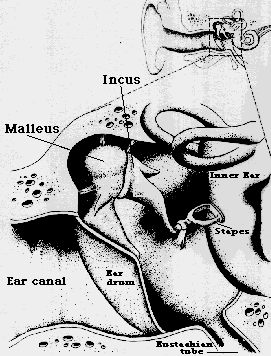
The Middle Ear Ossicular Chain - Malleus (Hammer) , Incus (Anvil) , and Stapes (Stirrup).
The middle ear contains three small bones known as the Malleus, Incus, and Stapes. (Fig. 2). These bones form a system of levers which are linked together and driven by the eardrum. Malleus pushing Incus, Incus pushing Stapes.

The Malleus, Incus, and Stapes. [Blake,1980]
Working together as a lever system, the bones amplify the force of sound vibrations.

EXAMPLE OF SIMPLE LEVER. [Goldstein, 1980]
The inner end of the lever moves through a shorter distance but exerts a greater force than the outer end.
In combination the bones double or triple the force of the vibrations at the eardrum.
The muscles of the middle ear modify the performance of this lever system as an amplifying unit. They act as safety devices to protect the ear against excessively large vibrations from very loud sounds - a sort of automatic volume control.
Although these tiny muscles - the smallest in the human body - at both ends of the ossicular chain can be moved voluntarily, their normal contractions are reflex triggered when sound exceeds a certain level. As the noise level rises, one set of muscles tightens to restrict the movement of the malleus thus weakening the vibrations transmitted within the middle ear. At the same time the stapes muscle contracts to pull the stapes away from the oval window so that less vibration is passed along to the very sensitive inner ear.
The Oval Window - Interface Between Middle & Inner Ear.
The stirrup passes the vibrations to the "oval window" which is a membrane
covering an opening in the bony case of the cochlea.
The size of the oval window compared to that of the eardrum (15 to 30 times smaller) produces the critical amplification needed to match impedances between sound waves in the air and in the cochlear fluid. Apart from the amplification of the bone lever system of the middle ear, this concentration of force amplifies the incoming vibrations of sound about 15 to 30 times.
Summary of the Amplifications from Outer to Inner Ear.
Within the 4 cm or so occupied by the outer and middle ears, three distinct physical
principles operate to magnify weak vibrations in air so that they can establish pressure
waves in a liquid:
1 The organ pipe resonance of the ear canal may increase the air pressure fore 10 times.
2 The mechanical advantages of the bone lever system may nearly triple it.
3 The pinpointing arrangement of the eardrum and the oval window may provide another thirty fold increase.
The result of these three mechanisms may be an amplification of a sound wave by more than 800 times before it sets the liquid of the inner ear in motion.